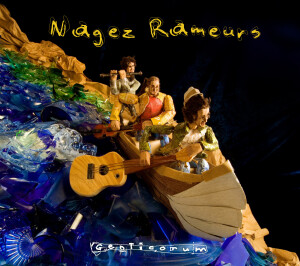 The French Canadian trio Genticorum has come a long way, both literally and figuratively. Since their beginnings around the turn of the Millennium, they have traveled the world, making friends and fans of their lively take on traditional francophone music. And they’ve also finely honed their craft. Just how far they’ve come is indicated by the honors they’ve received for Nagez Rameurs, their fourth album, which was named traditional album of the year and garnered them ensemble of the year title in the 2011 Canadian Folk Music Awards in December.
The French Canadian trio Genticorum has come a long way, both literally and figuratively. Since their beginnings around the turn of the Millennium, they have traveled the world, making friends and fans of their lively take on traditional francophone music. And they’ve also finely honed their craft. Just how far they’ve come is indicated by the honors they’ve received for Nagez Rameurs, their fourth album, which was named traditional album of the year and garnered them ensemble of the year title in the 2011 Canadian Folk Music Awards in December.
The three young men of Genticorum – Pascal Gemme on fiddle, vocals and foot percussion; Alexandre de Grosbois-Garand on flute, fiddle, vocals and more; and Yann falquet on guitar, vocals and Jew’s harp – pay homage to their heritage while putting their own mark on songs both traditional and “in the tradition.” The jigs, reels and more with call-and-response vocals and foot percussion reflect the mix of Scots, Irish and French elements that make up the region’s population and traditions, and they’re all delivered with an engaging blend of non-ironic good humor and an occasional dose of solemnity.
The trio’s vocal prowess is exemplified by the title track, which translates as “Row, oarsmen!” an unaccompanied song in which the three take turns singing the verses and all join on lovely harmony choruses. It’s a stately and nostalgic song of the early voyageur boatmen on the Hudson Bay. Voyages are the album’s main theme, starting with the very traditional-sounding first track “Tout le long du voyage,” with double fiddles and more of those vocal harmonies. “Grand voyageur sur la drave” is a slow and stately song about the old log drives down the mighty northern rivers; Grey Larsen (one of a handful of guests) chimes in here on harmonium. “Quand chus part du Canada” is a contemporary spin on a fellow’s travels around Canada, with the skirts in each city shorter than the last – it’s a dramatic reel, with a slightly modern sound imparted by electric bass guitar. A modern take on an old dance form, the gallop, is Gemme’s composition in honor of his cat “Sir Soft Tummy,” “Galop doux bedon.” And the band built a jig-reel suite called “Violon guérisseur (healing violin)” around a tune they learned from the Metis fiddler and healer Lawrence “Teddy Boy” Houle. The players’ instrumental chops are impressive on every song, but they really shine on “Reel circulaire,” which has lots of bounced grace notes and other fancy fiddle work. I’d also cast a vote for “Turlutte hirsute,” a great pun of a song title that means “hairy jig,” which is just brimming with music from guitar, fiddle, flute, feet and mouth music.
This is intimate and heart-warming music, made for social dancing. In terms of Quebecois folk music, it’s at the far end of the spectrum from the jazz-infused big-band juggernaut of La Bottine Souriante; it’s a testimony to the music’s versatility that both approaches are equally viable and equally enjoyable.
(Roues et Archets Canada / Mad River U.S., 2011)
